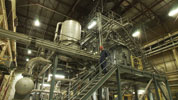

The marketplace for renewable fuels has received significant attention in recent years, with increased focus on technologies that provide fuel flexibility and reduction of greenhouse gas emissions. Recent legislation in many parts of the world, most notably the policies for Renewable Energy Sources and Renewable Energy Directive in the EU have increased the level of attention on new technologies that enable the sustainable production of renewable fuels.
To lessen reliance on petroleum-based fuels, governments around the world are calling for the development of ‘tomorrow’s biofuels’ as soon as possible. How does two seconds sound? That is the time it takes Envergent Technologies’ RTP (rapid thermal processing technology) to convert non-food biomass into pyrolysis oil. And RTP is a proven process that is sustainable, virtually carbon neutral, and in production in Canada and the US today.
Pyrolysis oil and Envergent
Pyrolysis oil is a light, pourable, clean-burning liquid produced from biomass feedstocks that do not compete with food crops. It is easily adaptable for a variety of energy applications, including heat and electrical generation, and shortly, pyrolysis oil will be upgradeable to green transportation fuels. It is also used to produce specialty chemicals.
One of Envergent’s parent companies – Ensyn Technologies – invented RTP in 1984 as a method to convert biomass to pyrolysis oil. RTP is the world’s only rapid pyrolysis process operating on a long-term commercial basis and today is used by seven plants in Canada and the United States to convert biomass to pyrolysis oil. That resulting oil is then used in the manufacture of more than 30 commercial products, from food flavourings to adhesive resins.
Envergent’s other parent company, Honeywell’s UOP, has been a leading developer of refining technologies and products for almost a century.
RTP Technology
The RTP process begins with readily available biomass (wood chips, straw or other cellulosic material) that is heated rapidly in a reactor with a circulating fluidised bed design. Hot gas enters the bottom of the reactor with hot sand, creating a whirlwind with a temperature of 500 to 525°C. Upon contact with the sand, biomass particles are pyrolysed, producing gas and solids. After the gas leaves the reactor, it is quenched rapidly to produce pyrolysis oil.
The solids that remain are a combination of sand and char, which are redirected to a second vessel. In the reheater, char is burned with the introduction of air to provide the necessary heat to bring the sand mixture to the temperatures required for pyrolysis in the reactor vessel. This is a key factor in increasing the net energy balance, and consequently, the greenhouse gas reduction of the end product.
Unlike slow pyrolysis, which can take hours, fast pyrolysis, like the RTP process, produces fewer emissions and offers maximum liquid production. RTP’s particular advantage is that it offers uniform and instantaneous heat transfer to the biomass and the ability to quench the gas into liquid quickly, producing higher quality pyrolysis oil. Additionally, the RTP process is more efficient at keeping char out of the final oil product.

Making green energy practical
Aside from its many environmental advantages, RTP is also very practical. Minimal utility and infrastructure requirements make RTP ideal for either remote or existing facilities. Compact, modular equipment minimises installation costs and takes up relatively little space. And it is highly scalable – designs from 100 to 1000 metric tonnes per day accommodate virtually any application.
RTP can also handle a wide range of readily available feedstocks – forestry and agricultural residuals, post-consumer, wood-based construction and demolition materials as well as sustainable energy crops such as poplar and willow, miscanthus and switchgrass.
On an energy basis, it is about 40% less expensive for businesses to produce and use pyrolysis oil than to purchase fuel oil for heat generation.
Pyrolysis oil can be used to generate green electricity in a specialised turbine at an affordable cost. The ability to produce electricity from pyrolysis oil in slow speed diesel engines, which is currently under development, will reduce the cost further due to increased electrical efficiency.
The oil has also been upgraded to green transportation fuel using UOP hydroprocessing technology to generate high value, renewable, green gasoline, diesel and jet fuel. These are virtually indistinguishable from their petroleum-based counterparts and can be used in today’s refining infrastructure and vehicles without modification. This technology is expected to be commercially available in 2012.
The future
Biomass energy conversion is particularly appealing to industries with supplies of residual biomass and a desire to reduce their carbon footprint. With a ready supply of sawdust and wood chips, the forest industry is a natural fit. The Forest Products Association of Canada (FPAC) recently unveiled a blueprint for reinvigorating Canada’s forest industry by integrating technologies like RTP with mill operations. The study showed that RTP technology was rated as fully ready for commercial deployment and would offer the highest return on capital employed. FPAC predicted that fast pyrolysis technology would turn Canada’s forest industry into an engine of growth in the region – producing jobs and clean energy to power mill operations, heat homes or provide green fuel for vehicles.
The United States Department of Energy recently awarded a grant to Envergent’s parent UOP for the construction of a demonstration unit in Hawaii to convert cellulosic biomass into green transportation fuel. The unit will produce pyrolysis oil from a variety of biomass residues, including woody biomass, algae, agricultural residues and energy crops like switchgrass and high-biomass sorghum, which will then be upgraded into green transportation fuels.
With global energy demand expected to double by 2030, traditional petroleum products will not be able to keep pace. Clearly, biofuels that use existing infrastructure and don’t compete with food, land or water, are the answer to growing global energy demands. With its proven, practical RTP process, Envergent is part of the solution – a solution that is available today.
For more information contact Debbie Rae, Honeywell Southern Africa, +27 (0)11 695 8000, [email protected], www.honeywell.co.za

© Technews Publishing (Pty) Ltd | All Rights Reserved